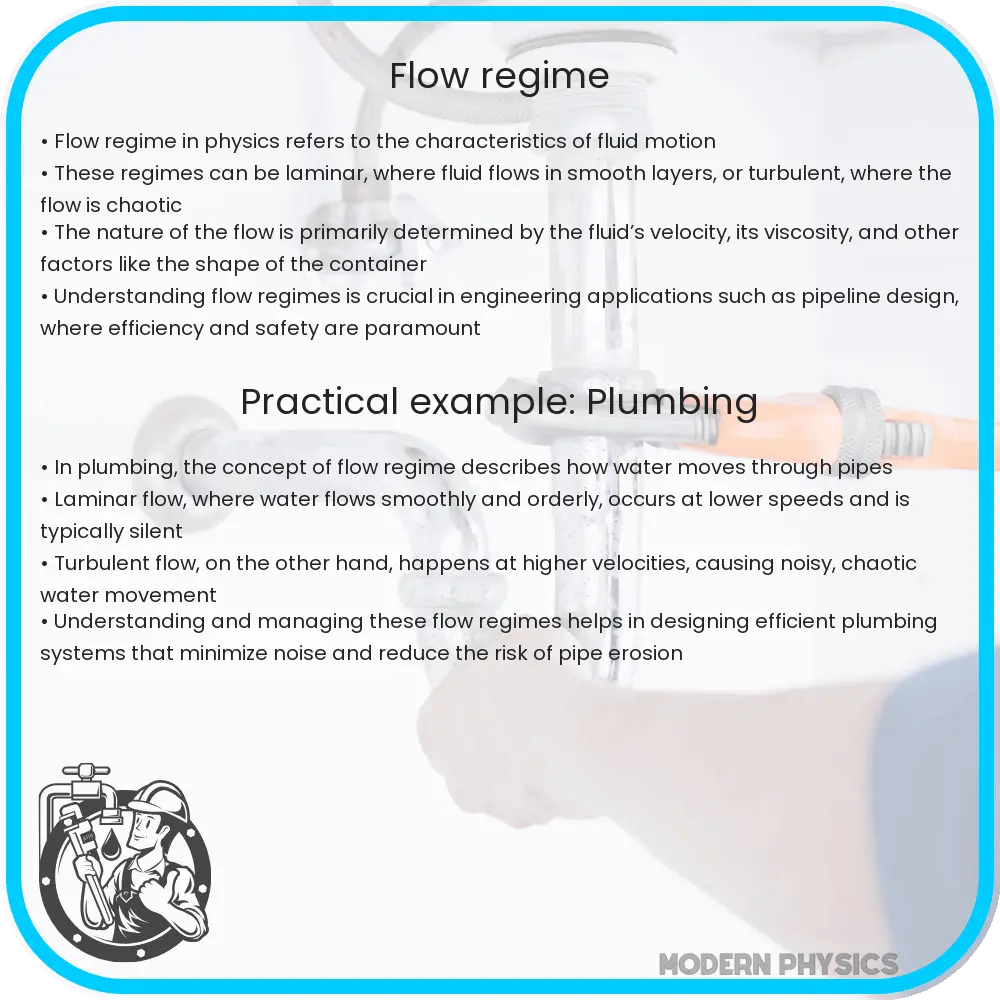Learn about flow regimes in fluid mechanics, covering laminar, transitional, and turbulent flows, and how factors like velocity and viscosity influence these patterns.

Understanding Flow Regimes in Fluid Mechanics
Flow regimes in fluid mechanics describe the different patterns and behaviors of fluid motion, which vary based on factors like fluid velocity, viscosity, and the physical characteristics of the flow channel. These flow patterns are critically important in engineering applications ranging from hydraulic design to aerospace engineering. In this article, we will explore the essential concepts around flow regimes, including their patterns, models, and the analysis techniques used to predict and understand fluid behavior.
Classification of Flow Regimes
Fluid flow regimes are primarily categorized into two types: laminar and turbulent. There is also a transitional flow that serves as the intermediate stage between the two. The type of flow regime present in a system can significantly affect heat transfer rates, pressure drops, and other hydraulic phenomena.
- Laminar Flow: In laminar flow, fluid particles move in smooth, orderly layers or streams with minimal mixing between the layers. This flow regime typically occurs at lower velocities and higher viscosities. The motion of the fluid can be effectively described using the Navier-Stokes equations.
- Transitional Flow: Transitional flow occurs when conditions are changing from laminar to turbulent flow. During this stage, small eddies and irregular flows begin to form, leading to an increase in flow instability.
- Turbulent Flow: Turbulent flow is characterized by chaotic fluid motions, eddies, vortices, and substantial mixing. This regime occurs at higher velocities and is the most common type of flow in engineering applications.
Reynolds Number: The Criterion for Flow Regime Determination
The Reynolds number (Re) is a dimensionless quantity used in fluid mechanics to predict the flow regime in different fluid flow situations. It is defined as:
Re = (rho * v * L) / mu
Where:
- rho (ρ) is the fluid density,
- v is the flow velocity,
- L is a characteristic length (such as diameter of a pipe), and
- mu (μ) is the dynamic viscosity of the fluid.
A higher Reynolds number typically indicates a turbulent flow, whereas a lower Reynolds number suggests laminar flow. The typical threshold values that distinguish these flow regimes are:
- Re < 2000: Laminar flow,
- 2000 < Re < 4000: Transitional flow,
- Re > 4000: Turbulent flow.
Modeling Flow Regimes
To analyze and predict the behavior of flow regimes, several models and simulations are employed. These models help in studying the complex dynamics of flow and assist in the design of systems for optimal fluid flow characteristics.
- Computational Fluid Dynamics (CFD): CFD is a powerful tool used in the simulation of fluid flows by numerical analysis and algorithms. It allows engineers to visualize and predict complex flow patterns and performance under different conditions.
- Direct Numerical Simulation (DNS): DNS resolves all scales of fluid motion and is typically used for detailed simulations of turbulent flows. Due to its high computational demand, DNS is generally applied only to relatively simple geometries or small-scale flows.
- Reynolds-Averaged Navier-Stokes (RANS) Equations: RANS models are used to calculate the mean flow behaviors by averaging out the turbulent fluctuations over time. This method is less computationally intensive than DNS and is widely used in engineering applications.
Practical Applications of Flow Regimes
Understanding and correctly predicting flow regimes are essential for the efficient design and operation of many engineering systems. Here are some practical applications:
- Aerospace Engineering: Aircraft and spacecraft employ fluid dynamics extensively, particularly in designing aerodynamically efficient shapes where controlling the boundary layer’s flow regime can reduce drag and improve performance.
- Chemical Engineering: In chemical reactors, the flow regime influences mixing and reaction rates critical for optimal reactor performance.
- Civil Engineering: For hydraulic structures like dams and channels, predicting flow regimes helps in assessing water flow and sediment transport capabilities, critical for preventing erosion and structural damage.
- Environmental Engineering: In wastewater treatment, flow regime control ensures that waste materials are properly mixed with treatment chemicals to ensure efficient processing.
Conclusion
Understanding flow regimes in fluid mechanics is pivotal for engineers across various disciplines. By classifying flow into laminar, transitional, or turbulent, engineers can predict how fluids will behave under different conditions. Moreover, using tools like the Reynolds number and advanced simulation techniques such as CFD, DNS, and RANS, professionals can design and optimize systems to enhance performance and efficiency.
Whether dealing with the sleek curves of an aircraft or the complex systems of a water treatment plant, mastery of fluid dynamics and its flow regimes leads to more effective and innovative engineering solutions. The continual development of more sophisticated models and simulations promises even greater advances in this essential field of engineering.
In conclusion, whether you’re a student or a professional in the field, gaining a thorough understanding of flow regimes and their practical applications not only enriches your theoretical knowledge but also opens up myriad opportunities for practical applications and innovations in technology.
